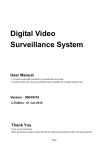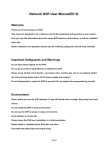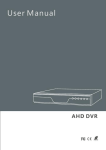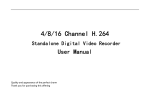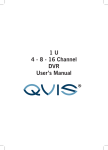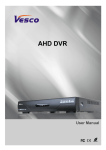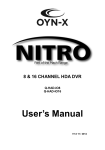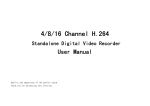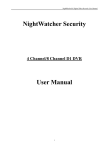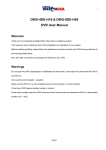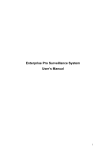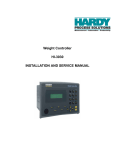Download DVR user manual - CCTV Wholesales
Transcript
DVR Fast Operation User Manual V1.1 Welcome Thank you for purchasing our DVR! This manual is designed to be a reference tool for the installation and operation of your system. Here you can find information about this series DVR features and functions, as well as a detailed menu tree. Before installation and operation please read the following safeguards and warnings carefully! Important Safeguards and Warnings Do not place heavy objects on the DVR. Do not let any solid or liquid fall into or infiltrate the DVR. Please brush printed circuit boards, connectors, fans, machine box and so on regularly. Before the dust cleaning please switch off the power supply and unplug it. Do not disassemble or repair the DVR by yourself. Do not replace the components by yourself. Environment Please place and use the DVR between 0℃ and 40℃.Avoid direct sunlight. Stay away from heat source. Do not install the DVR in damp environment. Do not use the DVR in smoky or dusty environment. Avoid collision or strong fall. Please insure the DVR level installation in a stable workplace. Please install in ventilated place. Keep the vent clean. Use within the rating input and output scope. 1 Overview IMPORTANT SAFETY INSTRUCTIONS Read these operating instructions carefully before using the unit. Follow all the safety instructions listed below. Keep these operating instructions handy for future reference. (1) Read these instructions. (2) Keep these instructions. (3) Heed all warnings. (4) Follow all instructions. (5) Do not use this apparatus near water. (6) Clean only with dry cloth. (7) Do not block any ventilation openings, Install in accordance with the manufacturer’s instructions. (8) Do not install near any heat sources such as radiators, heat registers, stoves, or other apparatus (including amplifiers) that produce heat. (9) Do not defeat the safety purpose of the polarized or grounding- type plug. A polarized plug has two blades with one wider than the other. A grounding type plug has two blades and a third grounding prong. The wide blade or the third prong is provided for your safety. if the provided plug does not fit into your outlet, consult an electrician for replacement of the obsolete utlet. (10) Protect the power cord from being walked on or pinched particularly at plugs, convenience receptacles, and the point where they exit from the apparatus. (11) Only use attachments/accessories specified by the manufacturer. (12) Use only with the cart, stand, tripod, bracket, or table specified by the manufacturer, or sold with the apparatus. When a cart is used, use aution when moving the cart/apparatus combination to avoid injury from tip-over. (13) Unplug this apparatus during lightning storms or when unused for long periods of time. (14) Refer all servicing to qualified service personnel. Servicing is required when the apparatus has been damaged in any way, such as power-supply cord or plug is damaged, liquid has been spilled or objects have fallen into 2 the apparatus, the apparatus has been exposed to rain or moisture, does not operate normally, or has been dropped. BEFORE START This manual provides operational information necessary for using the product and contains a description about each component part and its function as well as menu or network settings. You have to keep in mind the following notices: Qualvision retains the copyright on this manual. This manual cannot be copied without Qualvision’s prior written approval. We are not liable for any or all losses to the product incurred by your use of non-standard product or violation of instructions mentioned in this manual. Prior to opening the case, please consult a qualified technician first. Whenever this is needed power must be removed from the unit. Before installing additional HDD or connecting the SATA device to this product, check if it is compatible with the product. WARNING Battery It is essential that when changing the battery in the unit, the replacement battery must be of the same type otherwise there may be a possibility of an explosion. The following are the specifications of the battery you are using now. Normal voltage : 3V Normal capacity : 220mAh Discharge Current : 0.2mA Operating temperature : -20°C ~ +85°C (-4°F ~ +185°F) Caution Connect the power cord into a grounded outlet. The Mains plug is used as a disconnect device and shall stay readily operable at any time. Batteries shall not be exposed to excessive heat such as sunshine, fire or the like. Risk of Explosion if Battery is replaced by an Incorrect Type. Dispose of Used Batteries According to the Instructions. 3 System Shutdown Turning off the power while the product is in operation, or undertaking improper actions may cause damage or malfunction to the hard drive or the product. To safely cut off power, press the front Power button on the product to display the confirmation message. Click <OK> and then unplug the power cable. You may want to install a UPS system for safe operation in order to prevent damage caused by an unexpected power stoppage. (Any questions concerning UPS, consult your UPS retailer.) Operating Temperature The guaranteed operating temperature range of this product is 0°C ~ 40°C (32°F ~ 104°F) This product may not work properly if you run right after a long period of storage at a temperature below the guaranteed one. Prior to using a device that has been stored for a long period in low temperatures, allow the product to stand at room temperature for a period. Especially for the built-in HDD in the product, its guaranteed temperature range is 5°C ~ 55°C (41°F ~ 131°F) Likewise, the hard drive may not work at a temperature below the guaranteed one. Ethernet Port This equipment is in door use and all the communication wirings are limited to inside of the building. Security Precautions The default password can be exposed to a hacking thread so it is recommended to change the password after installing the product. Set password for your wireless network if you use the product with a wireless router. Being not protected with password or using the default wireless router password may expose your video data to potential threat. Note that the security and other related issues caused by the unchanged password shall be responsible for the user. 4 FEATURES The product compresses camera inputs from 4/8/16/24/32 channels with H.264 video codec, and supports simultaneous recording and playback of 8/16-channel audio input to/from HDD. These DVR also supports network connectivity, providing remote monitoring from a remote PC transferring video and audio data. Provides a convenient User Interface 4/8/16/24/32 CH Composite Input Connectors Supports CIF(S)/2CIF(M)/4CIF(L)/WD1 recording formats With the network specific codec, network transfer enabled regardless of the recording conditions Display of HDD information and status by using HDD SMART HDD overwrite function Mass storage HDD backup through high-speed USB 2.0 Simultaneous Record and Playback of 8/16-channel video data Various Search Modes (Time, Event, Backup, Pos, Motion Detection) Various Recording Modes (Manual, Event, Scheduled Recording) Alarm Interface Remote Monitoring function by Network Viewer, Smart Viewer and Mobile Viewer Supports coaxial protocols Tampering Detection PACKAGE CONTENTS Please unwrap the product, and place the product on a flat place or in the place to be installed. Please check the following contents are included in addition to the main unit. 5 PART NAMES AND FUNCTIONS (FRONT) num Button Part Names 1 Power 2 2 USB interface 3 Jog foreign key 4 Speed down 6 Functions Press to perform startup, shutdown operation. External USB storage device, mouse, burner, and so on. Real-time monitoring when left and right direction keys. Video file playback, a variety of slow speed, and normal playback. 5 6 7 8 Video file playback, a variety of Speed up fast speed, and normal playback. Forward playback or playback pause, press the button Rewind / pause backward playback. Backward playback, press this button to pause playback. Press the button forward playback. Pause playback. Play / Pause Pause resume playback In real-time monitoring status, press this key to directly enter video search menu. Play the video before current Last video video 9 Next video 10 Numeric keys 11 Arrow keys 12 Indicator Play the video next Input Digital Channel switching The current activated control switch, can be moved up or down Change the settings, change in number Show the system current status PART NAMES AND FUNCTIONS (REAR) 7 Part Names 1 2 3 4 5 6 7 8 9 10 11 12 Functions ATX power interface Fan outlet 16 channel loop out VGA video out SDI Video out Ethernet interface 1 USB interface 16 Alarm in / 16 Alarm out 1 Audio out 2 BNC video out 16 channel video in 16 channel Audio in REMOTE CONTROL Using the Numeric Buttons Serial number Name 1 Multi-window button 2 Numeric button 3 <Esc> Function Same function as Multi-window button in the front panel Code input/number input/channel switch Same function as<Esc>button in the 8 4 Direction button 5 6 7 8 Record control Record mode ADD FN front panel Same function as direction button in the front panel Control the record Same function as “Record mode” Input the number of DVR to control it Assistant function Changing the Remote Control ID ———————————————————————————————————————————————————————————————————————--------- 1. Press the <ID> button of the remote control and check the ID displayed on the DVR screen. The factory default ID of the remote control is 00. 2. Enter 2 digits of your selection in order, while pressing the system <ID> button. 3. When ID input is done, press the system <ID> button again to check the setting. CONNECTING EXTERAL DEVICES Connecting the USB —————————————————————————————————————————————————————————————————————————— (1) by factory default, a USB port is provided for external connection. (2) you can connect a USB HDD, USB CD/DVD player, USB memory or mouse to the USB port. (3) If a USB HDD is connected to the system, recognition and settings are available in “Main Menu” Æ “Device” Æ “Storage Device”. 9 (4) the product supports hot plugging function that enables connecting/disconnecting USB devices while in operating the system. Connecting External SATA HDD —————————————————————————————————————————————————————————————————————————— External SATA port is provided on the rear panel. If connected to the system, the external SATA HDD can be recognized and configured in “Main Menu” Æ “Device” Æ “Storage Device”. Connecting the Alarm Input/output —————————————————————————————————————————————————————————————————————————— The Alarm In/Out port at the back is composed of the following. ALARM IN 1 ~ 8 : Alarm Input Port. ALARM RESET: On receiving an Alarm Reset signal, the system cancels the current Alarm Input and resumes sensing. ALARM OUT 1 ~ 4 : Alarm Output Port. Connecting the RS-485 Device ——————————————————————————————————————————————————————————————————————— Connect the <TX/RX +, –> device through the back port. 10 Connecting the Network ——————————————————————————————————————————————————————————————————————— (1) Connecting to Network through Ethernet (2) Connecting to the Network using the router (3) Connecting to Network through PPPoE 11 Contents 1 Production Introduction .................................................................................................................................. 3 1.1 Product Overview ................................................................................................................................ 3 1.2 Main Functions .................................................................................................................................... 3 2 Open-package Check and Cable Connections ................................................................................................ 5 2.1 Open-package Check ........................................................................................................................... 5 2.2 Hard Disk Installation.......................................................................................................................... 6 2.3 Audio and Video Input and Output Connections ................................................................................. 6 2.3.1 Video Input Connections .......................................................................................................... 6 2.3.2 Video Output Connections and Options................................................................................... 7 2.3.3 Audio Signal Input..................................................................................................................... 7 2.3.4 Audio Signal Output.................................................................................................................. 7 2.4 Alarm Input and Output Connections .................................................................................................. 8 2.4.1 Alarm Input Port Specification.................................................................................................. 9 2.4.2 Alarm Output Port Specification ............................................................................................... 9 2.5 Speed Dome Connections.................................................................................................................... 9 3 Basic Operation ............................................................................................................................................ 10 3.1 Turn On.............................................................................................................................................. 10 3.2 Turn Off............................................................................................................................................. 10 3.3 System Login ..................................................................................................................................... 11 3.4 Preview .............................................................................................................................................. 11 3.5 Desktop Shortcut Menu ..................................................................................................................... 12 3.5.1 Main Menu ............................................................................................................................. 12 3.5.2 Playback .................................................................................................................................. 13 3.5.3 Record Mode........................................................................................................................... 17 3.5.4 Alarm Output .......................................................................................................................... 18 3.5.5 PTZ Control.............................................................................................................................. 18 3.5.6 Color Setting ........................................................................................................................... 24 3.5.7 Output Adjust.......................................................................................................................... 25 3.5.8 Logout ..................................................................................................................................... 25 3.5.9 Window Switch ....................................................................................................................... 25 4 Main Menu ................................................................................................................................................... 26 4.1 Main Menu Navigation...................................................................................................................... 26 4.2 Record................................................................................................................................................ 28 4.2.1 Record Config.......................................................................................................................... 28 4.2.2 Snapshot Storage .................................................................................................................... 29 4.2.3 Playback .................................................................................................................................. 31 4.2.4 Backup..................................................................................................................................... 31 4.3 Alarm Function .................................................................................................................................. 32 4.3.1 Motion Detect......................................................................................................................... 32 4.3.2 Video Blind.............................................................................................................................. 35 4.3.3 Video Loss............................................................................................................................... 36 4.3.4 Alarm Input ............................................................................................................................. 37 4.3.5 Alarm Output .......................................................................................................................... 37 4.3.6 Abnormal ................................................................................................................................ 37 4.4 System Setup ..................................................................................................................................... 38 4.4.1 General.................................................................................................................................... 38 4.4.2 Encode Setup .......................................................................................................................... 40 4.4.3 Network Setup ........................................................................................................................ 41 4.4.4 Net Service.............................................................................................................................. 42 4.4.5 GUI Display.............................................................................................................................. 48 4.4.6 PTZ Setup ................................................................................................................................ 50 4.4.7 RS232 Setup ............................................................................................................................ 51 4.4.8 Tour Setup............................................................................................................................... 51 4.4.9 Digital Channel Manager ........................................................................................................ 52 4.5 Advanced ........................................................................................................................................... 57 4.5.1 HDD manage ........................................................................................................................... 57 4.5.2 Account ................................................................................................................................... 58 4.5.3 Online User ............................................................................................................................. 61 4.5.4 TV Adjust................................................................................................................................. 61 4.5.5 Auto Maintain ......................................................................................................................... 61 4.5.6 Restore .................................................................................................................................... 62 4.5.7 Upgrade .................................................................................................................................. 62 4.5.8 Device Info .............................................................................................................................. 63 4.6 Info..................................................................................................................................................... 63 4.6.1 HDD Info.................................................................................................................................. 63 4.6.2 BPS .......................................................................................................................................... 64 4.6.3 LOG.......................................................................................................................................... 64 4.6.4 Version .................................................................................................................................... 65 4.7 Shut down System ............................................................................................................................. 65 5 CMS Software Operation ............................................................................................................................. 66 5.1 Installation Instruction ....................................................................................................................... 68 5.2 Introduction of Basic Functions......................................................................................................... 69 5.2.1 Preview ................................................................................................................................... 73 5.2.2 Right‐click Menu ..................................................................................................................... 74 5.2.3 PTZ Control.............................................................................................................................. 75 5.2.4 Color Setting ........................................................................................................................... 75 5.2.5 System..................................................................................................................................... 76 5.3 Local Config ...................................................................................................................................... 78 5.3.1 Base Config ............................................................................................................................. 78 5.3.2 Alarm Setting .......................................................................................................................... 79 5.3.3 Record Plan ............................................................................................................................. 79 5.3.4 DDNS Config............................................................................................................................ 80 5.3.5 Version Info ............................................................................................................................. 81 5.4 Remote Config................................................................................................................................... 81 5.4.1 Account ................................................................................................................................... 82 5.4.2 Local Log ................................................................................................................................. 83 5.4.3 Record Playback ...................................................................................................................... 85 5.4.4 Download & Backup................................................................................................................ 85 5.4.5 E‐MAP ..................................................................................................................................... 86 6 FAQ and Maintenance .................................................................................................................................. 90 6.1 FAQ ................................................................................................................................................... 90 6.2 Maintenance....................................................................................................................................... 95 2 1 Production Introduction 1.1 Product Overview The series DVR is designed especially for security and defense field which is an outstanding digital surveillance product. It introduces embedded LINUX operating system which is more stable. It introduces standard H.264mp video compressed format and G.711A audio compressed format which insures the high quality image, low error coding ratio and single frame playing. It introduces TCP/IP network technology which achieves the strong network communication ability and telecommunication ability. The series DVR can be used individually or online applied as a part of a safety surveillance network. With the professional network video surveillance software it achieves the strong network communication ability and telecommunication ability. The series DVR can be applied in the bank, telecom, electric power system, judicial system, transportation, intelligent housing, factory, storehouse, water conservancy and so on. 1.2 Main Functions Real-time Surveillance Analog interface and VGA interface (VGA interface is equipped selectively). Surveillance function through monitor or display. Storage Non-working hard disk dormancy processing which is convenient to radiate heat, reduce power and extend the life-span. Special storage format which insures the data safety. Compression Real-time compression by individual hard disk which insures the audio and video signal stable synchronization. 3 Backup Through SATA interface and USB interface such as USB equipment, removable hard disk and so on through net download the files in the hard disk. Playback Individual real-time video recording as well as searching, playback, network surveillance, recording check, downloading and so on. Multi-playback mode. Zoom at arbitrary region. Net Operating Through net tele-surveillance in the real time. Tele-PTZ control. Tele-recording check and real-time playback. Alarm Linkage Multi-route relay alarm output which is convenient for the alarm linkage and light control at the spot protecting circuits at the alarm input and output interface which protects the main machine from damage. Communication Interface RS485 interface which fulfills the alarm input and PTZ control. Standard Ethernet network interface which fulfills the telecommuting function. Intelligent Operating Mouse action function. Fast copy and paste operating for the same setting. 4 2 Open-package Check and Cable Connections 2.1 Open-package Check When you receive the DVR, please check first .First; please check whether there is any visible damage to the package appearance. The protective materials used for the package of the DVR can protect most accidental clashes during transportation. Then, please open the box and get rid of the plastic protective materials. Check whether there is any visible damage to the DVR appearance. At last, please open the machine crust and check the data wire in the front panel, power wire, the connection between the fan power and the main board. Front Panel and Rear Panel The key function specification in the front panel and the interface specification in the real panel are in the specification. Please check the product type in the front panel whether is accordant with the product type you order. The label in the real panel is very important for the after service Pleas protect it carefully When you contact us for after service please provided the product type and serial number in the label 5 2.2 Hard Disk Installation For the first use,please install the hard disk. 1 disassemble the screw ○ ②disassemble the cover ③fix the screw of hard disk ④fix the screw of hard disk ⑤connect the data wire ⑥connect the power wire 2.3 Audio and Video Input and Output Connections 2.3.1 Video Input Connections The video input port is BNC connector plug. The demand of input signal is PAL/NTSC BNC (1.0VP-P, 75Ω) The video signal must be accorded with the state standard which has the high signal to noise ratio, low aberration and low interference. The image must be clear and has natural color in the appropriate brightness. Insure the vidicon signal stable and credible The vidicon should be installed in the appropriate location where is away from backlighting and low illumination or adopts the better backlighting and low illumination compensation. The ground and power supply of the vidicon and the DVR should be shared and stable. Insure the transmission line stable and credible The video transmission line should adopt high quality coaxial pair which is 6 chosen by the transmission distance. If the transmission distance is too far, it should adopt shielded twisted pair, video compensation equipment and transmit by fiber to insure the signal quality. The video signal line should be away from the electromagnetic Interference and other equipment signal lines. The high voltage current should be avoided especially. Insure the connection stable and credible The signal and shield lines should be firm and connected credible which avoid false and joint welding and oxidation. 2.3.2 Video Output Connections and Options The video output is divided into PAL/NTSC BNC (1.0VP-P, 75Ω) and VGA output (selective configuration)When replace the monitor by the computer display, there are some issues to notice. (1) Do not stay in the turn-on state for a long time. (2) Keep the computer display normal working by demagnetizing regularly. (3) Stay away from the electromagnetic Interference. TV is not a credible replacement as a video output. It demands reducing the use time and control the power supply and the interference introduced by the nearby equipment strictly. The creep age of low quality TV can lead to the damage of other equipment. 2.3.3 Audio Signal Input (1) Audio port is BNC connection. (2) The input impedance is high so the tone arm must be active. (3) The audio signal line should be firm and away from the electro magnetic Interference and connected credible which avoid false and joint welding and oxidation. The high voltage current should be avoided especially. 2.3.4 Audio Signal Output Commonly the output parameter of DVR audio signal is greater than 200mv 1KΩ (BNC) which can connect the low impedance earphone and active sound box or other audio output equipment through power amplifier. If the sound box and the tone arm cannot be isolated, howling phenomena is often existed. There are some methods to deal with the above phenomena. 7 (1) Adopt better directional tone arm. (2) Adjust the sound box volume to be under the threshold that produces the howling phenomena. (3) Use fitment materials that absorb the sound to reduce reflection of the sound. (4) Adjust the layout of the sound box and the tone arm. 2.4 Alarm Input and Output Connections (1) Alarm Input A. Alarm input is grounding alarm input. B. Alarm input demand is the grounding voltage signal. C. When the alarm is connected with two DVR or connected with DVR and other equipment, it should be isolated by relay. (2) Alarm Output Alarm output cannot be connected with high-power load(no more than1A) When forming the output loop it must prevent the big current from relay damage. Use the contact isolator when there is a high-power load (3) PTZ Decoder Connections A. The grounding of the PTZ decoder and DVR must be shared otherwise the common-mode voltage will lead to the PTZ control failure. The shielded twisted pair is recommended. B. Avoid the entrance of high voltage. Make the layout reasonably. Take precaution from the thunder. C. In the outlying end connect 120Ω resistance paralleled to reduce the inflection and insure the signal quality. D. the 485 AB lines of DVR cannot connected with other 485 output equipment paralleled. E. The voltage between the AB lines of the decoder must be less than 5V. (4) Front e Equipment g Grounding Note Bad grounding can lead to the burnout of the chip. (5) Alarm Input Type Unlimited The DVR alarm output port is constant opening type. 8 (1) Alarm input. (2) Grounding. (3) RS232. (4) alarm output. (5) RS485 2.4.1 Alarm Input Port Specification 1 channel alarm input. Alarm input type unlimited. The grounding and the com port of the alarm sensor are parallel (The alarm sensor is external power supply) The grounding of the alarm and the DVR should be shared. The NC port of the alarm sensor must be connected with the DVR alarm input port. The grounding of the power supply and the alarm sensor must be shared when used in external power supply. 2.4.2 Alarm Output Port Specification 1 channel alarm output. There is external power supply when using the external alarm equipment. Please refer to the relay relevant parameters to avoid the overload that damages main machine. 2.5 Speed Dome Connections (1) Connect the 485 lines of the speed dome with the DVR 485 interface. (2) Connect the video line with the DVR video input. (3) Electrify the speed dome. 9 3 Basic Operation The button in gray display indicates nonsupport. 3.1 Turn On Plug the power supply and turn on the power supply switch. Power supply indicator light shining indicates turning on the video recorder. After the startup you will hear a beep. The default setting of video output is multiple-window output mode. If the startup time is within the video setting time, the timing video recording function will start up automatically. Then the video indicator light of corresponding channel is shining and the DVR is working normally. 1. Make sure that the input voltage corresponds with the switch of the DVR power supply. 2. Power supply demands: 220V±10% /50Hz. Suggest using the UPS to protect the power supply under allowable conditions. 3.2 Turn Off There are two methods to turn off the DVR. Entering <Main Menu> and choosing <Turn Off> in the <Turn off the system> option is called soft switch. Pressing the power supply switch is called hard switch. Illumination: (1) Auto resume after power failure. If the DVR is shut down abnormally, it can automatically backup video and resume previous working status after power failure. (2) Replace the hard disk Before replacing the hard disk, the power supply switch in the real panel must be turned off. (3) Replace the battery . Before replacing the battery, the setting information must be saved and the power supply switch in the real panel must be turned off. The DVR uses button battery. The system time must be checked regularly. If the time is not correct you must replace the battery, we recommend replacing the battery every year and using the same battery type. 10 The setting information must be saved before replacing the battery otherwise information will lose. 3.3 System Login When the DVR boots up, the user must login and the system provides the corresponding functions with the user purview. There are three user settings. The names are admin, guest and default and these names have no password. Admin is the super user purview; guest and default’s permissions are preview and video playback. User admin and guest’s password can be revised, while their permissions can’t be revised; user default is the default login user whose permission can be revised but not its password. Figure 3.1 System Login Password protection: If the password is continuous wrong three times, the alarm will start. If the password is continuous wrong five times, the account will be locked. (Through reboot or after half an hour, the account will be unlocked automatically) For your system security, please modify your password after first login. 3.4 Preview You can right click mouse to choose the switch between the windows. The system date, time and channel name are shown in each viewing window. The surveillance video and the alarm status are shown in each window. 11 Table 3.1 Preview icon 1 Recording status 3 Video loss 2 4 Camera lock Motion detect 3.5 Desktop Shortcut Menu In preview mode you can right click mouse to get a desktop shortcut menu. The menu includes: Main Menu, Record Mode, PlayBack, PTZ Control, High Speed PTZ, Alarm Output, Color Setting, Output Adjust, Logout, View1/4/8/9/16 screens. Figure 3.2 Shortcut Menu 3.5.1 Main Menu When you login, the system main menu is shown as below. 12 Figure 3.3 Main Menu 3.5.2 Playback There are two methods for you to play the video files in the hard disk. (1) In the desktop shortcut menu. (2) <Main menu> Æ <Record> Æ <Playback> The hard disk that saves the video files must be set as read-write or read-only state. (4.5.1) 13 Figure 3.4 video playback 1. Listed files 4. File backup 2. File information. 5. Operation hint 3. File searching 6. Playback control <Listed files> Look up the listed files that accord with the searching criteria. <File information> Look up the found file information. <File backup> Backup the chosen file. Click the button and operate as followed. The storage must be installed before the file backup. If the backup is terminated, the already backup can playback individually. 14 Figure 3.5 detect the storage <Detect> Detect the storage connected with the DVR such as hard disk or universal disk. <Erasure> Choose the file to delete and click erasure to delete the file. <Stop> Stop the backup. <Backup> Click backup button and the dialog box is popped up. You can choose the backup file according to the type, channel and time. Figure 3.6 recording backup 15 <Remove> Clear the file information. <Add> Show the file information satisfying the set file attributes. <Start/Pause> Click the play button to start the backup and click the pause button to stop the backup. <Cancel> During backup you can exit the page layout to carry out other functions. <File searching> Search the file according to the searching parameter. Figure 3.7 file searching <File type> Set the searching file type. <Channel> Set the searching channel. <Start Time> Set the searching time scan. <Playback Control> Refer to the following sheet for more information. Table 3.2 Playback control key Button Function / Button Function Play/pause Backward Stop Slow play Fast play Previous frame Next frame Previous file 16 Next file Circulation Full screen Frame by frame playback is only performed in the pause playback state. <Operation hint> Display the function of the cursor place. Special functions: <Accurate playback> Input time (h/m/s) in the time column and then click play button. The system can operate accurate playback according to the searching time. <Local zoom> When the system is in single-window full-screen playback mode, you can drag your mouse in the screen to select a section and then left click mouse to realize local zoom. You can right click mouse to exit. 3.5.3 Record Mode Please check current channel status: “○” means it is not in recording status, “●” means it is in recording status. You can use desktop shortcut menu or click <Main menu> Æ <recording function> Æ <recording set> to enter the recording control interface. Figure 3.8 Record Mode <Schedule> Record according to the configuration. <Manual> Click the all button and the according channel is recording no matter the channel in any state. <Stop> Click the stop button and the according channel stops recording no matter the channel in any state. 17 3.5.4 Alarm Output Please check current channel status: “○” means it is not in alarming status, “●” means it is in alarming status. You can use desktop shortcut menu or click <Main Menu> Æ <Alarm Function> Æ <Alarm Output> to enter the alarm output interface. Figure 3.9 alarm output <Configuration> Alarm is on according to the configuration. <Manual> Click the all button and the according channel is alarming no matter the channel in any state. <Stop> Click the stop button and the according channel stops alarming no matter the channel in any state. 3.5.5 PTZ Control Operation interface is as followed. The functions include: PTZ direction control, step, zoom, focus, iris, and setup operation, patrol between spots, trail patrol, boundary scan, assistant switch, light switch, level rotation and so on. Decoder A (B) line connects with DVR A (B) line. The connection is right. Click <Main menu> Æ<System configuration> Æ<PTZ setup> to set the PTZ parameters. The PTZ functions are decided by the PTZ protocols. 18 Figure 3.10 PTZ setup <Speed> Set the PTZ rotation range. Default range: 1 ~ 8. <Zoom> Click / button to adjust the zoom multiple of the camera. <Focus> Click / button to adjust the focus of the camera. <Iris> Click / button to adjust the iris of the camera. <Direction Control> Control the PTZ rotation. 8 directions control is supportive.(4 directions in Front panel is supportive). <High Speed PTZ> Full-screen show channel image. Left press mouse and control PTZ to rotate orientation. Left press mouse and then rotate the mouse to adjust the zoom multiple of the camera. <Set> Enter the function operation menu. <Page Switch> Switch between different pages. Special functions: 1. Preset Set a location for the preset, calls the preset points, PTZ automatically turns to the setting position . 1) Preset option Set a location for the preset, procedure is as follows: Step1: in Picture 3.10, click the Direction button will turn into preset position, click the Settings button to enter Picture 3.11. Step 2: click the Preset button, and then write the preset points in the input blank, Step 3: click Settings button, return the Picture 3.10 Complete setup, that is the preset points and preset position corresponds. 19 Clear Preset: Input preset points, click Remove button, remove the preset. Figure 3.11 Preset Settings 2) Preset Point Calls In Picture 3.10, click Page Shift button, enter PTZ control interface as shown in Picture 3.12. In the input blank, write the preset points, then click Preset button, PTZ turn to the corresponding preset point. Preset button Preset point input blank. Figure 3.12 PTZ Control 2. Cruise between Points Multiple preset points connected cruise lines, call cruise between points, the PTZ run around on the line. 1) Cruise Between Points Settings 20 Cruise lines are connected by multiple preset points, setting procedure is as follows: Step1: In Picture 3.10, the Direction key will turn PTZ to designated location, click Settings button to enter Picture 3.13. Step 2: Click Cruise buttons, the write proper value into the Cruise Line and Preset Points blank,then click Add Preset Points button, complete setting (also can add and delete cruise line which has been set up). Step 3: Repeat step1 and step2, until set out all the preset designated cruise lines. Remove Preset: Please input preset value in the blank, click Remove Preset button, then remove the preset points. Remove Cruise Line: Input the number of cruise line, click Remove Cruise Lines button, then remove the cruise lines set. Figure 3.13 Cruise Between Points Settings 2) The Calls of Cruise between Points In Picture 3.10, click Page Shift button, enter PTZ control menu as shown in Picture 3.12. Please input the number of cruise in the value blank, then click Cruise between Points button, PTZ begins to work on the cruise line. Click Stop button to stop cruise. 3. Scan PTZ also can work on the preset scan line repeatedly. 21 1) Scan setup Step1: In Picture 3.10, click Setup button,enter Picture 3.14; Step2: Click Scan button,the input proper value in the scan value blank; Step3: Click Start button, enter Picture3.10,here you can set the following items: Zoom/Focus/Aperture/Direction and so on. Click Setup button to go back Picture 3.14; Step4: Click End button to complete setup. Click the right button of the mouse to exit. Figure 3.14 Scan Setup 2) Scan Calls In Picture 3.10, click Page Shift button, then enter PTZ control menu as shown in Picture 3.12. Please input the number of scan in the value blank, and then click Scan button,PTZ begins to work on the scan line . Click Stop button to stop. 4. Boundary Scan 1) Boundary Scan setup Step1: In Picture 3.10, click Direction button to turn the PTZ to preset direction, then click Setup button enter Picture 3.15, select the left boundary, return to Picture 3.10; Step2: Please click direction arrows to adjust PTZ direction, click Setup button enter Picture3.15, and then select the right boundary, return to Picture 3.10; Step3: Complete setup, that is the position of left and right boundary 22 Figure 3.15 Boundary Scan Setup 2) Boundary Scan Calls In Picture 3.10, click Page Shift button, then enter PTZ control menu as shown in Picture 3.12. Please input the number of scan in the value blank , then click Scan button,PTZ begins to work on the scan line . Click Stop button to stop. 3) Horizontal Rotating Click Horizontally Rotating button, PTZ begins to rotate horizontally (relative to the original position of the camera) Click the Stop button to stop. 4) Rotate Click on horizontal Rotating button, PTZ turn around. 5) Reset Line scan button border. PTZ restart, all the data clears to 0. 6) Page Shift In Picture 3.12, click Page Shift button into Picture3.16, setting auxiliary function. Auxiliary number corresponding to auxiliary switch on the decoder. 23 Figure 3.16 Auxiliary Function Control <Intuitive Auxiliary Operation> Choose auxiliary equipment, select Open or Close button, switch control. <Auxiliary Number> The operation of corresponding auxiliary switch according to PTZ agreement. <Page Shift> In Picture 3.16,click Page Shift button enter the Picture 3.17 PTZ Main Menu , the menu itself can be control by the menu control buttons. 3.5.6 Color Setting Set the selective image parameters (current channel for single window display and cursor place for multi-window display) You can use the desktop shortcut menu and enter the interface. The image parameters include: tonality, brightness, contrast, saturation. You can set different parameters at different time sections. Figure 3.18 Color Setting 24 3.5.7 Output Adjust Adjust TV output area parameters. You can use the desktop shortcut menu or enter <Main Menu> Æ <Management Tools> Æ <Output Adjust>. Figure 3.19 Output Adjust 3.5.8 Logout Logout shut down the system or reboot up. You can use the desktop shortcut menu or enter <Main menu>. Figure 3.20 Logout/Shutdown/Reboot the system <Logout> Quit the menu. Offer password next entrance. <Shut down> Quit the system. Turn off the power supply. When press the shutdown button, there is schedule hint. After three seconds, the system is shut down. Cancel midway is of no effect. <Reboot> Quit the system. Reboot up the system. 3.5.9 Window Switch Preview in single window/four windows/eight windows/nine windows/sixteen windows according to your choice. 25 4 Main Menu 4.1 Main Menu Navigation Main Menu Sub Menu Function Set the recording configuration, recording type, Config recording time section Set recording look-up, recording play, video file Record Playback storage Detect or format backup equipment, back the backup selective files Set motion detect alarm channel, sensitivity, Motion area, linkage parameters: defending time detection section, alarm output, screen hint, recording, PTZ, patrol Set camera mask alarm channel, sensitivity, linkage Video blind parameters: defending time section, alarm output, screen hint, recording, PTZ, patrol Set video loss alarm channel, linkage Alarm parameters: Video loss defending time, section, alarm output, screen hint, recording, PTZ, patrol Set alarm input channel, equipment type, linkage Alarm input parameters: defending time section, alarm output, screen hint, recording, PTZ, patrol Set alarm mode: configuration, manual, shut Alarm output down Set system time, data format, language, hard System General disk full time operation, machine number, video configuration configuration format, output mode, summertime, stay time Set main(assistant)coding parameter: code mode, resolving ability, frame rate, code stream Encode control, configuration image quality type, code stream value, frame between value, video/audio enable Set basic network parameters, DHCP and DNS Network parameters, network configuration high speed download PPPOE, NTP, Email, IP purview, DDNS Net Service parameter 26 Set channel name, preview hint icon state, GUI display transparency, cover area, time title, channel time fold PTZ Set channel, PTZ protocol, address, baud rate, configuration date bit, stop bit, check Serial port Set serial port function, baud rate, date bit, stop Configuration bit, check (RS232) Tour Set patrol mode and interval time Set appointed hard disk as read-write disc, Hard disk read-only management disc or redundant disc, clear data, resume date and so on User Modify user, team or password. Add user or management team. Delete user or team. Break the connection with the already login Online user user. Lock the account after, break until booting up again. Management tools Adjust TV upside, downside, nearside, TV adjust starboard distance Automatic Set automatic reboot system and automatic maintenance deleting files. Resume setup state: common setup, code setup, recording setup, alarm setup, network setup, Restore network service, preview playback, serial port, setup, user management Hard disk Display hard disk capability and recording time information Code stream Display code stream information statistics System information Log Clear all log information according to the log information video and time Edition Display edition information information Shut down Logout, shut down or reboot 27 4.2 Record 4.2.1 Record Config Set the recording parameters in the surveillance channel. The system is set 24 hours consecutive recording in the first startup. You can enter <Main Menu> Æ <Recording function>Æ<Recording setup> to set. There is at least one read-write hard disk.(refer to chapter 4.5.1) Figure 4.1 Record Config <Channel> Choose the corresponding channel number to set the channel. Choose the all option to set the entire channels. <Redundancy> Choose the redundancy function option to implement the file double backup function. Double backup is writing the video files in two hard disks. When you do the double backup, make sure that there are two hard disks installed. One is read-write disk and the other is redundant disk. (refer to 4.5.1). <Length> Set the time length of each video file. 60minutes is default value. <PreRecord> Record 1-30 seconds before the action. (Time length is decided by the code stream). <Record mode> Set video state: schedule, manual or stop. 28 Schedule: Record according to the set video type (Common, detection and alarm) and time section. Manual: Click the button and the according channel is recording no matter the channel in any state. Stop: Click the stop button and the according channel stops recording no matter the channel in any state. <Period> Set the time section of common recording. The recording will start only in the set range. <Record type> Set recording type: regular, detection or alarm. Perform the regular recording in the set time section. The video file type is “R”. Detect: Trigger the “motion detect”, “camera mask” or “video loss” signal. When above alarm is set as opening recording, the “detection recording” state is on. The video file type is “M”. Alarm: Trigger the external alarm signal in the set time section. When above alarm is set as opening recording, the “detection recording” state is on. The video file type is “A”. Regular: Refer to chapter 4.3 to set corresponding alarm function. 4.2.2 Snapshot Storage Setup snapshot parameters for different channels. At first time it's set for 24hours snapshot continuously, plus go to <Main Menu> Æ <Record> Æ <Snapshot Storage> for appropriate settings. If normal snapshot storage, plus setup Snap at <Main Menu> Æ <Advanced> Æ <Snapshot> (plus refer to chapter 4.5.1 HDD Manage). 29 Figure 4.2 <Channel> Select the related channel to set, click "all" to set all channels. <Presnap> Setup presnap picture quantity before recording, default is 5 pieces. <Record> Set record status, "Schedule", "Manual" and "Stop": Schedule: Realize snapshot according to record type (regular, detect and alarm) and period. Manual: No matter what the present channel is in a state, once choose "manual" button, it will have snapshot at related channels. Stop: No matter what the present channel is in a state, once choose "stop" button, it will stop snapshot at related channels. <Period> Set normal record period, it only startup Snapshot Storage at set period. <Type> Three types: Regular, detect and alarm. <Record type> Three types: Regular, detect and alarm. Regular: snapshot at set period. Detect: snapshot at set period when motion detect, video blind and video loss which are preset for snapshot enable. Alarm: snapshot at set period when alarm in which is preset for snapshot enable. For related alarm function, plus refer to chapter 4.3. 30 4.2.3 Playback Refer to chapter 3.5.2. 4.2.4 Backup You can back up the video files to external storage through setup. The storage must be installed before the file backup. If the backup is terminated, the already backup can playback individually. Figure 4.3 Backup <Detect> Detect the storage connected with the DVR such as hard disk or universal disk. <Erase> Choose the file to delete and click erasure to delete the file. <Stop> Stop the backup. <Backup> Click backup button and the dialog box is popped up. You can choose the backup file according to the type, channel and time. 31 Figure 4.4 File Backup <Remove> Clear the file information. <Add> Show the file information satisfying the set file attributes. <Start/pause> Click the play button to start the backup and click the pause button to stop the backup. <Cancel> During backup you can exit the page layout to carry out other functions. 4.3 Alarm Function Alarm functions include: motion detect, video blind, video loss, alarm input and alarm output. 4.3.1 Motion Detect When system detects the motion signal that reaches the set sensitivity, the motion detect alarm is on and the linkage function is turned on. 32 Figure 4.4 Motion Detect <Channel> Choose the set motion detect channel. <Enable> Means that the motion detects function is on. <Sensitivity> Choose in the six options according to the sensitivity. <Region > Click setup and enter the set area. The area is divided into PAL22X18. Green block means the current cursor area. Yellow block means the dynamic detect defensive area. Black block means the unfenced area. You can set the area as followed, Drag the mouse and draw the area. Figure 4.5 Region <Period> Trigger the motion detect signal in the set time section. You can set according to week or set uniformly. Each day is divided into four time sections. ‘■’ means the set valid. 33 Figure 4.6 set the time section <Interval> Only one alarm signal is turned on even there are several motions detect signals in the set interval. <Alarm output> Start the external equipment of corresponding linkage alarm when the motion detection alarm is turned on. <Delay> Delay a few moments and stop when the alarm state is turned off. The range is 10~300 seconds. <Record channel> Choose the recording channel (multiple options supportive)Trigger the video signal when the alarm is turned on. Set in the <recording setup> and perform the linkage recording. Start detecting video files in the corresponding time section. <Tour> Meaning that the selective channel is single window alternate patrol preview. The interval is set in the <Main Menu> Æ <System> Æ <Tour>. <Snapshot> Choose record channels, when alarm happens, system triggers related channels for snapshot signal. For Snapshot activation, plus go to set period, detect and alarm enable at <Main Menu>Æ<Record>Æ<Record config>. 34 <PTZ Activation>Set the PTZ activation when the alarm is turned on. PTZ activation is set in the <Shortcut menu> Æ <PTZ control>. Set the patrol between spots, trail patrol and so on. Figure 4.8 PTZ Activation <Delay> When alarm is over, recording will last some seconds (10~300sec), then stop. <Show message> Pop the alarm information dialog box in the local host computer screen. <Send EMAIL> Means to send an email to user when the alarm is turned on. Set in the <Net Service> and send email. 4.3.2 Video Blind When the video image is influenced by the environment such as bad brightness or reaching the set sensitivity parameter, the camera mask function is turned on and the linkage function is turned on. 35 Figure 4.9 Video Blind Set method: refer to chapter 4.3.1. Motion detect “Advanced” button is the same as right click. 4.3.3 Video Loss When the equipment cannot obtain the channel video signal, the video loss alarm is turned on and the linkage function is turned on. Figure 4.10 Video loss Set method: refer to chapter 4.3.1. Motion detect 36 “Advanced” button is the same as right click. 4.3.4 Alarm Input When the equipment obtains the external alarm signal, the alarm function is turned on. Figure 4.11 Alarm input Set method: refer to chapter 4.3.1. Motion detect "Advanced" button is the same as right click. 4.3.5 Alarm Output Refer to chapter 3.5.4. 4.3.6 Abnormal Analyzing and inspecting current software and hardware of the device: When some abnormal events happen, the device will make a relative answer such as show message and buzzer. 37 Figure 4.12 Abnormal <Event Type> selecting abnormity you want to inspect. <Enable> Select it to make sure abnormal function workable. <Show message> Automatically alarm cue dialog box come out of the main screen. <Buzzer> Device will have two long voice “beep” while alarm is happening. 4.4 System Setup Set the system parameters such as General, Encode, Net Work, Net Service, GUI Display, PTZ Config, RS232 and Tour Setup. 4.4.1 General Figure 4.13 General setup 38 <System time> Set the system data and time. <Date format> Choose the data format: YMD, MDY, and DMY. <Date Separator> Choose list separator of the data format. <Time Format> Choose time format: 24-hour or 12-hour. <Language> English. French. Portuguese, Russian, Italian, S-Chinese, T-Chinese, Spanish, Thai, Greek, Japanese, German, Polish. <HDD full> Choose stop record: Stop recording when the hard disk is full. Choose overwrite: Cover the earliest recording files and continue recording when the hard disk is full. <DVR No. > Only when the address button in the remote controller and the corresponding DVR number is matched, the remote operation is valid. <Video Standard> PAL or NTSC. <Auto Logout> Set the latency time in 0-60. 0 means no latency time. <DST> Choose the summer time option and pop the dialog box as followed. Figure 4.14 DST (week) Figure 4.15 DST (date) 39 4.4.2 Encode Setup Set the video/audio code parameter: video file, remote monitoring and so on. Set every independent channel’s coding parameter in the left part, and set the combine encode parameter in the right part. Combine encode introduces video compression technique which combines and compresses multi-channel’s video to a special channel. Applying for Multi-channel playback simultaneously, Dial-up multi-channel real-time monitor, mobile monitor and so on. Figure 4.16 Encode setup <Channel> Choose the channel number. <Compression> Standard H.264 main profile. <Resolution> Resolution type: D1/ HD1/CIF / QCIF. <Frame Rate> P: 1 frame/s~25 frame/s; N: 1 frame/s~30 frame/s. <Bit Rate Type> You can choose limited code stream or variable code stream. When you choose the variable code stream there are six image quality options. <Bit Rate> Set the code stream value to modify the image quality. The larger code stream value the better image quality. D1(1000~1500kbps) , 40 CIF(384~1500kbps) , QCIF (64~512kbps). <Video/Audio> When the icons are all in reverse displayed, the video file is video and audio multiplex stream. Combine Enable. <Combine Enable> When the icons are all in reverse displayed, opening combination coding functions. <Mode> Multi-channel playback is used in all channels playback imultaneously, and the narrowband transmission is used in multi-channel real-time remote monitoring simultaneously at narrowband state, especially used in mobile monitor. 4.4.3 Network Setup Figure 4.17 Network <Net Card> You can choose cable network card or wireless network card. <DHCP Enable> Obtain IP address automatically (not suggested) DHCP server is preinstalled. <IP address> Set the IP address. Default: 192.168.1.10. <Subnet mask> Set the subnet mask code. Default: 255.255.255.0. <Gateway> Set the default gateway. Default: 192.168.1.1. 41 <DNS setup> Domain Name Server. It translates the domain name into IP address. The IP address is offered by network provider. The address must be set and reboot then it works. <TCP port> Default: 34567. <HTTP port> Default: 80. <HS Download> High Speed Download. <Transfer Policy> There are three strategies: self-adaption, image quality precedence and fluency precedence. The code stream will adjust according to the setup. Self-adaption is the tradeoff between the image quality precedence and fluency precedence. Fluency precedence and self-adaption are valid only when the assistant code stream is turned on. Otherwise image quality precedence is valid. 4.4.4 Net Service Choose the network service option and click the set button to conFigurethe advanced network functions or double click the service button to conFigurethe parameters. Figure 4.18 Net Service <PPPoE Setup> Input the user name and password that ISP(Internet service provider) provides. After saving it reboot up your system. Then the DVR will build a network connection based on PPPoE. The IP address will change into dynamic IP address after above operation is well done. 42 Figure 4.19 PPPoE Operation: After PPPoE dialing successfully look up the IP address in the <IP address> and obtain the current IP address. Then use this IP address to visit the DVR through user port. <NTP setup> The NTP server must be installed in the PC. Figure 4.20 NTP <Host computer IP> Input the IP address installed NTP server. <Port> Default 123. You can set the port according to NTP server. <Time zone> London GMT+0 Berlin GMT +1 Cairo GMT +2 Moscow GMT +3 New Delhi GMT+5 Bangkok GMT +7 Hong Kong Beijing GMT +8 Tokyo GMT +9 Sydney GMT +10 Hawaii GMT-10 Alaska GMT-9 Pacific time GMT-8 American mountain time GMT-7 American mid time GMT-6 American eastern time GMT-5 Atlantic time GMT-4 Brazil GMT-3 Atlantic mid time GMT-2. <Update Period> The same with the NTP server check interval. Default: 10minutes. <EMAIL setup> If the alarm is turned on or the alarm linkage photos are taken. Send an email about the alarm information and the photos to appoint address. 43 Figure 4.21 EMAIL <SMTP Server> Email server address. It could be an IP address or domain name. Domain name can be translated only it is the correct DNS configuration. <Port> Email server port number. <SSL> Decide whether using Secure Socket Layer protocol to login. <User Name> Apply the email server user name. <Password> Input the password corresponding to the user. <Sender> Set the email sender address. <Receiver> Send the email to appointed receivers when the alarm is turned on. You can set three receivers at most. <Title> You can set as you wish. <IP Filter setup> When choosing the white list, only the listed IP address can connect the DVR. The 64 IP addressed are supportive in the list. When choosing the black list, the listed IP address cannot connect the DVR. The 64 IP addressed are supportive in the list. You can delete the set IP address by √ in the options. When the same IP address is in the white and black list at the same time, the black list precedence is higher. 44 Figure 4.22 IP FILTER <DDNS> It is the abbreviation of dynamic domain name server. <Local domain name> Provide the domain name registered by DDNS. <User name> Provide the account registered by DDNS. <Password> Provide the password registered by DDNS. When the DDNS is successfully configured and start, you can connect the domain name in the IE address column to visit. The DNS setup must be configured correctly in the network setup. 45 Figure 4.23 DDNS setup <FTP Setup> FTP is available only when alarm happens, or alarm activates record and snapshot, it will upload related record and napshot pictures to FTP server. Figure 4.24 FTP setup <Enable> Click Enable, then all settings will be available. <Server IP> IP address for FTP server. <Port> Domain Port of FTP, default 21. <User Name> User name of FTP. <Password> Password of user. <Max File Length> Max length for upload files at every packed, default 128M. <Dir. Name> Directory of uploading files. <Wireless Config> ADSL through 3G net card, use CMS to visit and config the device. 46 Figure 4.25 Wireless Config <Enable> Choose Enable to make all settings available. <Type> Dial type, default AUTO. <Wireless AP> 3G access point. <Dial Number> 3G Dial Number. <User Name> User name of 3G. <Password>Password of dial user. <IP Address> IP address, got from dial. <Mobile Monitor Setup> To visit the device by mobile, plus make a router mapping of this port and use CMS to monitor and operate it by protocol. Figure 4.26 Mobile Monitor Setup <Enable> Select it to make sure abnormal function workable. 47 <Port> <UPNP> It’s a port of mobile monitoring which you need to make a router mapping of if want to visit it by mobile. UPNP protocol can auto port forwarding on router, make sure UPNP is running on router before use it. Figure 4.27 <Enable> Choose Enable to make sure all UPNP settings available. <HTTP> Route will automatically distribute HTTP port for the device, when IE viewing, it needs this port (e.g. 60.12.9.26:66) <TCP> Router will automatically distribute TCP port for the device, when monitoring via CMS, it need this port. <Mobile Port> Router will automatically distribute Mobile Port for the device, when mobile monitor, it need this port. 4.4.5 GUI Display ConFigurethe video output parameters including the front output mode and code output mode. Front output: In the local preview mode include: channel title, time display, channel title, record status, alarm status, bitrate info, transparency and region cover. Code output: In the network surveillance and video file mode include: channel title, time display, channel title, record status, alarm status, bitrate info, transparency and region cover. 48 Figure 4.28 GUI Display <Channel Title> Click the channel name modify button and enter the channel name menu. Modify the channel name. The 16 Chinese characters and 25 letters are supportive. <Time Display> Means the selective state. Display the system data and time in the surveillance window. <Channel Title> Means the selective state. Display the system channel number in the surveillance window. <Record Status> Means the selective state. Display the system recording status in the surveillance window. <Alarm Status> Means the selective state. Display the system alarm status in the surveillance window. <Bitrate info> Means the selective state. The ninth window displays the code stream information in the nine-window preview status. <Transparency> Choose the background image transparency. The range is128~255. <Resolution> Set display resolution. <Channel> Choose the set code output channel number. <Region Cover> Means the selective state. Click the cover area button and enter the corresponding channel window. You can cover the arbitrary using mouse. (Black region is for output) 49 4.4.6 PTZ Setup Figure 4.29 PTZ setup <Channel> Choose the dome camera input channel. <Protocol> Choose the corresponding dome protocol. (PELCOD as an example) <Address > Set as the corresponding dome address. Default: 1. The address must be consistent with the dome address. <Baud rate> Choose the corresponding dome baud rate length. You can control the PTZ. Default: 115200. <Data bits> Include 5-8 options. Default: 8. <Stop bits> Include 2 options. Default: 1. <Parity> Include odd check, even check, sign check, blank check. Default: void. 50 4.4.7 RS232 Setup Figure 4.30 RS232 setup <Serial Port Function> Common serial port is used to debug and update program or set up specific serial port. <Baud rate> Choose the corresponding baud rate length. <Data bits> Include 5-8 options. <Stop bits> Include 2 options. <Parity> Include odd, even, mark, space. 4.4.8 Tour Setup Set the patrol display. ‘ ’ means that the tour mode is turned on. You can choose the single window, four windows, nine windows; sixteen windows patrol display or single display. 51 Figure 4.31 tour setup <Interval> Set the patrol switch interval. The set range is 5-120 seconds, meaning turn off/on the patrol. 4.4.9 Digital Channel Manager Digital channel manage includes digital channel, channel status and channel type mode. There is only channel type when all analog channel mode. Figure 4.32 Full analog channel mode 52 Figure 4.33 Mixed mode (1) Digital Channels Figure 4.34 Single-link digital channel Figure 4.35 Multi-channel digital 53 <Channel> select channel title; <Enable> Open digital channel, tick enable, then can do related settings; <Time Synchronization> Tick it means the time of this channel and device is the same. <Connection Mode> can be singe connect or multi-ink, multi-link modes can connect to several devices, device will be tour displayed one by one, tour interval can be set, no less then 10s; <Delete> If the user want to change device, select the existing device, click delete will be ok. <Add> Click add will come out below page to add new device: Figure 4.36 Remote access configuration <Configur. Name> Device is with default config title, users can revise it as you like; <Device Type> There are three types: IPC, DVR, HVR, the user can choose as what you like, default is IPC; <Protocol> System default is TCP protocol; <Remote Channel> Users can input remote channel title from the device that you want to connect remotely; <Stream> User can input remote channel title from the device that you want to connect remotely; <Device address> IP address of device; <Port> Default is 34567; <User name> Default is admin; 54 Click the ‘Search’ button, will show all the devices that searched out, user can choose any of the device that you like. Figure 4.37 Remote channel configuration (2)Channel status Channel status is to show the status of all the digital channel, including Max Resolution, This Resolution, Connection Status. For example: The channel status for 4+2 mode is as below: Figure 4.38 A ‘Unknown’ status 55 Figure 4.39 All-digital Channel status Under all digital channel mode, Max resolution of channel 3 is D1, if it was connected to a device with resolution over D1 ( such as 960H), you will see below: Figure 4.40 A red "X" 56 (3) Channel mode Figure 4.41 Channel Type The system support mode of 0+6, 4+2, 2+4, 0+4, 0+2 etc., user can shift the mode as they like. 4.5 Advanced 4.5.1 HDD manage ConFigureand manage the hard disk. The menu displays current hard disk information: hard disk number, input port, type, status and overall capability. The operation include: setup the write-read disk, read-only disk, redundant disk, hard disk format, resume default. Choose the hard disk and click the right function button to execute. Read/Write Disk: The equipment can write or read data. Read-only Disk: The equipment can read data but cannot write data. Redundant Disk: Double backup the video files in the write-read disk. 57 Figure 4.42 HDD Manage 4.5.2 Account Manage the user purview. (1) the character length is 8 bytes at most for the following user and user team name. The blank ahead or behind the character string is invalid. The middle blank in the character string is valid. Legal characters include: letter, number, underline, subtraction sign and dot. (2) There is no limit in the user and user group. You can add or delete the user group according to user definition. The factory setup include: user\admin. You can set the team as you wish. The user can appoint the purview in the group. (3) The user management includes: group and user. The group and user name cannot be the same. Each user only belongs to one group. 58 Figure 4.43 Account <Modify User> Modify the existed user attribute. <Modify Group> Modify the existed team attribute. <Modify Password> Modify the user password. You can set 1-6 bit password. The blank ahead or behind the char string is invalid. The middle blank in the char string is valid. The user who possess the user control purview can modify his/her own or other users password Figure 4.44 Modify Password <Add User> Add a user in the team and set the user purview. Enter the menu interface and input the user name and password. Choose 59 the team and choose whether cover using the user. Cover using means that the account can be used by multiple users at the same time. Once choose the team the user purview is the subclass of the team. We recommend that the common user’s purview is lower than the advanced user. Figure 4.45 Add User <Add Group> Add a user team and set the purview. There are 36 different purviews: shut down the equipment, real time surveillance, playback, recording setup, video file backup and so on. Figure 4.46 Add Group <Delete User> Delete the current user. Choose the user and click delete user button. <Delete Group> Delete the current group. Choose the group and click delete group button. 60 Figure 4.47 Delete Group 4.5.3 Online User Look up the network user information in the local DVR. You can choose the network user and cut the connection. Then the user is locked until next boot-strap. Figure 4.48 Online User 4.5.4 TV Adjust Refer to chapter 3.5.7. 4.5.5 Auto Maintain The user can set the auto reboot time and auto file deleting time limit. 61 Figure 4.49 Auto maintain 4.5.6 Restore The system restore to the default setup. You can choose the items according to the menu. Figure 4.50 Restore 4.5.7 Upgrade Figure 4.51 Upgrade 62 <Upgrade> Choose USB interface. <Upgrade File> Choose the file which needs upgraded. 4.5.8 Device Info Provide device interface info like audio in, alarm in/out to be conveniently used for user. Figure 4.52 Device Info. 4.6 Info 4.6.1 HDD Info Display the hard disk state: hard disk type, overall capability, residual capability, the recording time and so on. Figure 4.53 HDD Info 63 Clue: ‘○’ means that the hard disk is normal. ‘X’ means that the hard disk is broken-down. ‘-‘ means that there is no hard disk. If the user needs to change the damaged hard disk, you must shut down the DVR and take up all the damaged hard disks, then install a new one. Behind serial number means the current working disk such as ‘1*’. If the corresponding disk is damaged, the information will show “?”. 4.6.2 BPS Display the code stream(Kb/S) and hard disk capability (MB/H) in real time. It displays as the wave sketch map. Figure 4.54 BPS 4.6.3 LOG Look up system log according to the set mode. Log information include: system operation, configuration operation, data management, alarm affair, recording operation, user management, and file management and so on. Set the time section to look up and click the look up button. The log information will display as a list. (One page is 128 items) Press Page up or Page down button to look up and press delete button to clear all the log information. 64 Figure 4.55 LOG 4.6.4 Version Display the basic information such as hardware information, software edition, and issue data and so on. Figure 4.56 Version 4.7 Shut down System Refer to chapter 3.5.8. 65 5 CMS Software Operation The Central Management Software (CMS) is a powerful and professional centralized monitoring system designed for all range of applications and projects. With CMS, accessing and monitoring multiple surveillance equipment such as DVRs, and Mega-Pixel IP cameras is just a few clicks away. The feature-packed intelligent surveillance offers the professional users with complete and enhanced surveillance experiences. FEATURES User and authority management Support N level organization management, user management and authority setup management. Data interface technology All data exchanged use data interface technology, so it can support kinds of database very Flexibility, such as SQL, MYSQL, XML data and so on. Support adding device by EXCEL The platform supports the user adopts Excel to add and edit devices. It's very convenience for user to maintain quantities of devices, improving system's usability and greatly reducing lots of maintenance work. Intelligent video transport protocol Intelligent video transport protocol can maximize the using of network 66 bandwidth. Especially on the condition of Front-end network bandwidth limited, based on the system assures the high quality Image, even in the low network bandwidth, it can work well. Scalable and distributed network architecture Supporting multi servers to run coordinately, and load balancing intelligent. It is flexibility to add server and enhance the system capacity on the condition of assuring the integrity of the system. Perfect video monitoring While running real time monitoring, the system can support alarm, recording, auto monitoring record, playback and so on. It can exactly control the recording status of every channel. Dynamic regulation decoding buffer It is flexibility to adjust the fluency/real-time of video images in real-time monitoring, which can meet different users’ demands. Central management Centralized management of data throughout the system and the function of data forwarding provide the perfect multi-user real-time monitoring program. Remote users can real-time monitor, record and playback through network. Easy operation In access control, users can easily control and set all monitor points through the system. It also integrates E-map function. High integration level The system integrates other related functions, like Alarm, Voice, etc. High reliability The system designs a special fault tolerance measures to assure data Integrity and the system to run dependability. Good scalability The system designs for Service, has a good scalability and adaptability to maximally protect user investment. z Support Network management and load balancing z Support multi devices volume upgrade via network z Support user DIY interface and multi languages z Support 4 channels real-time playback z Support connecting multi devices and viewing many videos (Real-time monitoring and playback) 67 5.1 Installation Instruction (1) Find "CMS_ChnEng_V1.0.0.6.T.20090315.Exe" in the CD and run it like below figure. (2) Click "Next”, then go the below figure. (3) Click "Browser" to select setup path (default path "C:\Program Files"), then click "Next" to select Start Menu folder like below figure. 68 (4) Click "Next" to start setup and end setup like below figure. (5)Click "Finish" to end the setup, at the time it will come up this icon in the desktop .Plus follow Chapter 3,4,5 instructions to operate this software after finish installation. 5.2 Introduction of Basic Functions (a) Run it, default user name: super, no password. 69 (b) Choose<System> Æ<Device Manage>, see below figure. (c) Add Device, see below figure. 70 <Login Type> IP address, domain name, and serial ID. Add IP address: IP search: IP search and manually add IP address. Click “IP search” and select the DVR IP address to add device. Manually add IP address: Fill with IP address, TCP port, user name, and password, then you can click <add device>to add device. (d) Double click the device name, then choose main stream or extra stream, see below picture. Device display area In this area, you can preview live screens by device and do super account administrator setting. You can click device name or channel group to change channel. Operation area You can preview live screens, also can click right key to do system configuration and video searching in this area. Time 71 Display the current time. Video disk status area It can display the free disk spaces which are used to store video files. PTZ Control and operate the PTZ. Operation log It will record every operation action information when you operate the system. Menu Area Users could set single menu and sub-menu in this area, and select relevant menus to operate video surveillance system in the control center. Diagram Menu Configuration First Second Third No. Menu Menu Menu 1 Preview 2 PTZ 3 Color 4 System Function & Instruction Operating right Click preview button "Monitor" to choose a preview of the screen, touring & switching among Admin/User all channels and snapshot pictures of the screen. Shut down/open preview menu Controlling the speed cameras to go up, down, left, right and stop by operating panel, adjusting Admin/User speed, zoom, focus, iris and auto pan, presetting and touring. Set brightness ,contrast, saturation and hue for Admin/User video screen Device Add manager zone Add device Add zone for all devices Admin/User Add video devices Admin/User 72 surveillance 5 6 7 8 9 10 11 12 13 14 15 Modify device name, IP Modify address, user name and password Delete video surveillance Delete devices Base Select disk, disk list and Local config logs maintenance Config Alarm Enable audio activated by setting alarm Add and delete users' Group operating rights Add, delete and manage Account users: User Set user name, password and operating rights of menu Search alarm log and Local operation log in set time Log area. Search record file and Playback playback Record Record Set record time for every Plan day Decoder Set DVR and decoder Using this map, it can visually show every Advance cameras location and find Map current monitoring page directly 5.2.1 Preview Diagram Functions and instructions of preview No. Button Meanings 1 click it to preview full screen for every channel 2 click it to preview 4 screens 3 click it to preview 9 screens 73 Admin/User Admin/User Admin/User Admin/User Admin Admin Admin/User Admin/User Admin/User Admin/User Admin/User No. Button Meanings 4 click it to preview 16 screens 5 click it to preview 25 screens 6 click it to preview 36 screens 7 click to preview 64 screens 7 click it to enter full screen interface 5.2.2 Right-click Menu At operating area, user can do below operation by right-click: <Close window> Close the current screen. <Close all window> Close all the current screens. <Audio> Click it and hear the voices from preset screens. <Local record> Click it to record at current channel and save the record to the relevant disk. <Zoomed> Select it to realize enlarge the part of screen you select. <Start talk> Start to connect the audio to realize talk. <Snapshot> Capture pictures from current channel at any time and save it to relevant disk. 74 <Device config> Click it and go to device configuration interface. <Color Setting> Adjust the color of the current screen. <View Full> See the current screen full screen. 5.2.3 PTZ Control When speed cameras are connected with DVR, user can control it at this center, turn up, down, left and right, stop running, adjust turning speed, zoom, focus and iris, preset and tour configuration. When users enable touring function, the speed cameras will tour according to preset. Button Function means "turn", means "stop turning" Drag this pole to adjust speed rate Click to zoom in, Click to zoom out Click to focus in, Click to focus out Click to iris in, Click Click to start PTZ, Click to iris out to stop PTZ Set a location for the preset, calls the preset points, PTZ automatically turns to the setting position. You can add, delete and conFigurepreset point Multiple preset points connected to tour lines. If you call touring between points, the PTZ will run around on the line 5.2.4 Color Setting Button Function Brightness 75 Button Function Contrast Saturation Hue Click to resume initial values. 5.2.5 System Device manager,here to manage the device. (a) Click (e) Click to add zone, see below figure. to add a zone to add device, see below figure. <Device Name> Device name. <Domain> Domain name by external network such as xxxx.3322.org, xxxx.dyndns.org, xxxx.oray.org etc.. <IP Address> IP address. <Port> TCP port. <User Name> User name. <Password> User password. 76 Click "OK" after you have done above parameters, see the picture, you could double click to open this device.Choose only one of Domain name and IP address. Double click the device name, the sub menu will display, as below figure. You can double click to choose one or more channel to display. to modify device, see below picture. After finishing all the (c) Click modifications, click "OK". (d) Delete device: Choose the devices which you want to delete, then click . Please make sure the device is disconnected before modifying and deleting it. (e) Click to import a device configuration that you export before. (f) Click to export the current device configuration. 77 (g) Click to test if the current network is ok. 5.3 Local Config 5.3.1 Base Config <Log maintence> The days of alarm and operation log keep. 78 <Picture DIR> The directory of location picture storage. <Snapshot Format> The format of snapshot, you can choose BMP or JPG. <Record DIR> The directory of location record storage. <Sync time with PC> Adjusting device and PC in order to make both at the same time. <Language> Choose language of CMS. 5.3.2 Alarm Setting <Device List> Choose set alarm parameter. one device to <Alarm Enable> Click it to make sure all alarm functions available. <Alarm Prompt Sound> Select any alarm prompt sound which you like. Open sound file path: Browse and choose prompt sound. <Auto Watch Warn> Choose it to add following channels by alarm activated. Please go to choose alarm type first. 5.3.3 Record Plan You can set your record plan for every channel. You also can choose a record 79 template for every day. <Overwrite> Click it, and then it will cover the old records when HDD is full. <Length> The length of the time of one record file. <Alarm Record Delay> The system will record ten seconds after the alarm stopping. <Disk List> C, D, E, F. Edit Template, see right figure. After setting name, you can set one day record periods as you like, then click "Add" and "OK". Choose "channel" first, then go to set record time from Monday to Sunday. After set record plan, If it need to record, please make sure the below three points. (1) Choose a disk for recording at Local config. (2) make sure the device is connected to network. (3) Make sure local computer is always open. 5.3.4 DDNS Config To analyze server via dynamic domain name, you can conFigurethe DDNS. 80 <Server IP> The domain name that analyze server. <Port> The default value is 15000. When the DDNS is successfully configured and start, you can use the domain name in the IE address column to visit. 5.3.5 Version Info <Version Info> CMS's version. (Build Date, video, net, decoder, device config, Net, Playback) 5.4 Remote Config Select a device first, then set its configurations, see below figure. 81 The function of this part you can refer to chapter Main Menu guideline. 5.4.1 Account (1) Group You can add & delete user group, also can set user group permission, see below figure. (2) User You can add user, delete user and modify user password, also can select a 82 group for user, see below figure. 5.4.2 Local Log You could search menu operation log, and alarm log by time, see right figure. The operation log includes. 83 The alarm log includes: . You also can export the log message to local PC. 84 5.4.3 Record Playback There are two playback modes, including Remote playback and Local playback. <Remote playback> Playback at Device-side. <Local playback> Playback at Client-side. User could playback record files of any times, max playback channel is four. Button Function Play Pause Stop Slow play Fast play Last frame Next frame 5.4.4 Download & Backup You can playback record files at the time and channels you select. Click "Download/Backup" and select "Browse" to choose a directory to save record 85 files. 5.4.5 E-MAP E-MAP is a plan for simulating live screen, user can use it to add & delete cameras and set e-map alarm activation, see below figure. (1) Click "Edit" first at the left bottom, then click "Picture Edit", see below figure. (2) Click picture, see "Add" to add below figure. (3) After set picture name, description, picture path, then click "OK" and back to main interface. Click "Picture" and drag one picture to the right side, see right figure. 86 (4) Click "Device" to drag device's channel to the map, then the channel name will appear at the map, double-click it to name and describe it. Tour : Video touring makes the different channels in turn displays in a display box. All the channels in Management software can be displayed. (a) Click the icon , you will enter into right interface, selecting "Add" to go to next step. (b) Click the "Add" button, you can develop a touring scheme, also can delete and change the scheme. 87 (c) In the software operating area, select a window, and then click the right mouse button, choosing tour project and selecting one in this menu, you can achieve video touring operations. Task Config Task configuration can be set up to connect the extra video stream. You can do volume settings to the video channel, according to the actual needs of different scenarios. (a) Click the icon to next step. , you will enter into right interface, selecting "Add" to go (b) Click the "Add" button, you can develop a task scheme, also can delete and change the scheme. 88 (c) In the CMS area at the left side of the device tree, you can select task configuration, as right figure 89 6 FAQ and Maintenance 6.1 FAQ If the problems are not listed, please contact the local service or call the HQ service. We are willing to offer the service. (1) The DVR cannot boot up normally. Possible reasons are as followed: 1 The power supply is not correct. 2 Switch power supply line is not in good connection. 3 Switch power supply is damaged. 4 The program updating is wrong. 5 The hard disk is damaged or the hard disk lines are broken. 6 The front panel is damaged. 7 The main board of the DVR is damaged. (2) The DVR reboots automatically or stops working after boot up a few minutes. Possible reasons are as followed: 1 The input voltage is not stable or too low. 2 The hard disk is damaged or the hard disk lines are broken. 3 The power of the switch power supply is low. 4 Frontal video signal is not stable. 5 Bad heat radiator or too much dust or bad running circumstance for the DVR. 6 The hardware of the DVR is damaged. (3) System cannot detect hard disk. Possible reasons are as followed: 1 The hard disk power supply line is not connected. 2 The cables of the hard disk are damaged. 3 The hard disk is damaged. 4 The SATA port of main board is damaged. (4) There is no video outputs in single channel, multiple channels and all channels. Possible reasons are as followed: 1 The program is not matched. Please update the program. 2 The image brightness is all 0. Please restore the default setup. 3 There is no video input signal or the signal is too weak. 4 The channel protection or the screen protection is set. 90 5 The hardware of the DVR is damaged. (5) Real-time image problems such as the image color or the brightness distortion. Possible reasons are as followed: 1 When using the BNC output, the option between the N mode or PAL mode is wrong and the image becomes black and white. 2 The DVR is not matched the monitor impedance. 3 The video transmission distance is too far or the loss of the video transmission line is too large. 4 The color and brightness setting of the DVR is wrong. (6) I cannot find the video files in local playback mode. Possible reasons are as followed: 1 The data line of the hard disk is damaged. 2 The hard disk is damaged. 3 Update the different program with the origin program files. 4 The video files to look up are covered. 5 The recording is not on. (7) The local video is not clear. Possible reasons are as followed: 1 The image quality is too bad. 2 The reading program is wrong. Reboot up the DVR. 3 The data line of the hard disk is damaged. 4 The hard disk is damaged. 5 The hardware of the DVR is damaged. (8) There is no audio signal in the surveillance window. Possible reasons are as followed: 1 It is not an active tone arm. 2 It is not an active sound box. 3 The audio lines are damaged. 4 The hardware of the DVR is damaged. (9) There is audio signal in the surveillance window but mo audio signal in the playback state. Possible reasons are as followed: 1 Setting issues: the audio option is not chosen. 2 The according channel is not connected with the video. (10) The time is wrong. Possible reasons are as followed: 1 Setting is wrong.. 2 The battery is in bad connection or the voltage is too low. 91 3 The oscillation is damaged. (11) The DVR cannot control the PTZ. Possible reasons are as followed: 1 There is something wrong with the frontal PTZ. 2 The setting, connection or the installation of the PTZ decoder is not correct. 3 The connections are not correct. 4 The PTZ setting of the DVR is not correct. 5 The protocols of the PTZ decoder and the DVR are not matched. 6 The address of the PTZ decoder and the DVR are not matched. 7 When multiple decoders are connected, the far port of the PTZ decoder line A (B) must connect a 120 Ω resistance to reduce the reflection otherwise the PTZ control is not stable. 8 The distance is too far. (12) The motion detect is not working, Possible reasons are as followed: 1 The time range set is not correct. 2 The motion detect area set is not correct. 3 The sensitivity is too low. 4 Limited by some hardware edition. (13) I cannot login via web or CMS. Possible reasons are as followed: 1 The system is windows 98 or wins me. We recommend updating to windows 2000sp4 or higher Version or installing the software for low edition. 2 ActiveX is hold back. 3 The version is not exceeded dx8.1. Update the display card driver. 4 Network connection failure. 5 Network setting issues. 6 Invalid password or user name. 7 The CMS is not matched the DVR program version. (14) The image is not clear or there is no image in network preview state or video file playback state. Possible reasons are as followed: 1 Network is not stable. 2 The user machine is resource limited. 3 Choose the play-in-team mode in the network setup of DVR. 4 The region shelter or channel protection is set. 5 The user has no surveillance purview. 6 The real-time image of the hard disk recording machine itself is not clear. 92 (15) Network connection is not stable. Possible reasons are as followed: 1 Network is not stable. 2 IP address is conflicted. 3 MAC address is conflicted. 4 The net card of the DVR is bad. (16) There is something wrong with the USB backup or writing a CD. Possible reasons are as followed: 1 The rewritable machine and the hard disk are shared the same data lines. 2 The data is too much. Please stop recording and backup. 3 The data exceeds the backup storage. 4 The backup equipment is not compatible. 5 The backup equipment is damaged. (17) The keyboard cannot control the DVR. Possible reasons are as followed: 1 The serial port of the DVR is not set correctly. 2 The address is not correct. 3 When multiple transformers are connected, the power supply is not large enough. Please give each transformer individual power supply. 4 The distance is too far. (18) Alarm cannot be recessional. Possible reasons are as followed: 1 The setting of the alarm is not correct. 2 The alarm output is turned on manually. 3 The input machine is damaged or the connections are not correct. 4 There are some problems for specific program edition, Please update the program. (19) Alarm is not working. Possible reasons are as followed: 1 The setting of the alarm is not correct. 2 The connection of the alarm is not correct. 3 The alarm input signal is not correct. 4 A alarm is connected with two loops synchronously. (20) The remote controller is not working, Possible reasons are as followed: 1 The remote control address is not correct. 2 The remote control distance is too far or the angle is too large. 3 The battery is used up. 93 4 The remote controller or the front panel of the recording machine is damaged. (21) The storage time is not enough. Possible reasons are as followed: 1 Front vision quality is bad. The lens is too dirty. The vision is in backlighting installation. 2 The hard disk capability is not enough. 3 The hard disk is damaged. (22) The downloading files cannot play. Possible reasons are as followed: 1 There is no media player. 2 There is no DX8.1 software or higher edition. 3 There is no DivX503Bundle.exe file to play AVI video files. 4 The DivX503Bundle.exe and ffdshow-2004 1012 .exe files must be installed in the windows xp system. (23) I cannot remember the advanced code or network code in the local menu operation. Please contact the local service or call the HQ service. We will offer the service according the machine type and the program edition. (24) Q: under win7 system, IE control can not be automatically download and installation Possible reasons are as followed: 1 Manual install IE plug-in, not as administrator identity installation, lead to installation does not completely or invalid. The right mouse button click need to install the control, and then select installation as an administrator 2 Automatic download control of time is intercept system; Can the computer on the following operation: "start"--" run "input" msconfig and then select "tools"--" change the UAC Settings "set for "never notice" 3 Control is antivirus software intercept, when installation can shut off the anti-virus software, and then install, after the success of the installation to put us set to trust the control software. (25) Q: under win7 system, CMS installation failure, or after installation, cannot open CMS software control is antivirus software intercept, when installation can shut off the anti-virus software, and then install, after the success of the installation to put us set to trust the control software. Possible reasons are as followed: 1 Not as administrator identity installation, lead to installation does not completely or invalid. 94 6.2 Maintenance (1) Please brush printed circuit boards, connectors, fans, machine box and so on regularly. (2) Please keep the grounding well done to prevent the video or audio signal interfered and the DVR from static or inductive electricity. (3) Do not pull out the video signal line or RS-232 port or RS-485 port with the power on. (4) Do not use the TV in the local video output port (VOUT) of DVR. It will damage the video output circuit easily. (5) Do not turn off the switch directly. Please use the turn-off function in the menu or press the turn-off button in the panel (3 seconds or longer) to protect the hard disk. (6) Please keep the DVR away from heat resource. (7)Please keep the DVR ventilated for better heat radiator. Please check the system and maintain regularly. 95










































































































